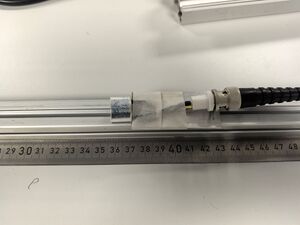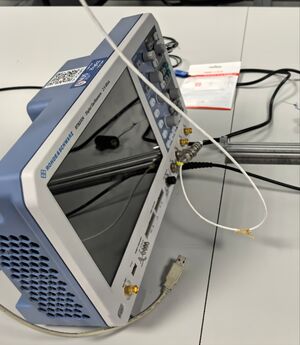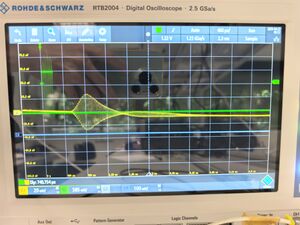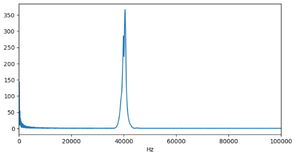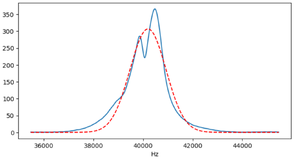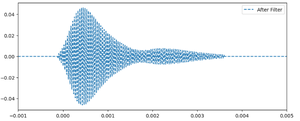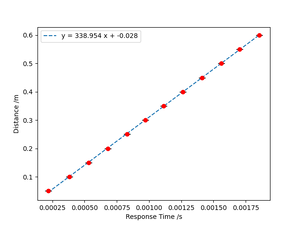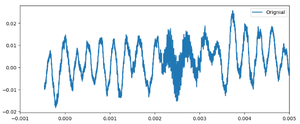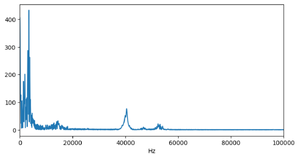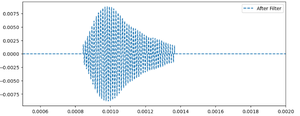Ultrasonic Doppler Speedometer
Introduction
The ultrasonic Doppler speedometer operates based on the transmission and reflection of high-frequency acoustic waves, utilizing the Doppler effect to determine the velocity of moving objects. In this system, a square wave signal at approximately 40 kHz, generated by a signal source such as an oscilloscope, drives an ultrasonic transmitter to emit coherent sound waves. These waves travel through the ambient medium (typically air), interact with moving targets, and are reflected back. The reflected signals are subsequently captured by an ultrasonic receiver and visualized on an oscilloscope for further analysis.
The primary objective of this experiment is to construct a complete ultrasonic Doppler measurement system, structured sequentially through square wave generation, acoustic wave emission, echo reception, and oscilloscope signal acquisition. Through this implementation, the experiment seeks to enhance the understanding of acoustic wave propagation dynamics, Doppler frequency shifting principles, and time-of-flight analysis. Moreover, it provides hands-on experience in signal conditioning, noise reduction, and quantitative velocity extraction techniques.
Compared to traditional mechanical or optical methods, ultrasonic Doppler systems offer notable advantages including non-contact operation, superior real-time responsiveness, and reduced susceptibility to environmental noise. The simplicity of the circuit design, combined with low operational costs, makes this technique highly suitable for both educational purposes and fundamental research in dynamic system monitoring and flow diagnostics.
Principles
The Doppler effect describes the change in the observed frequency of a wave when there is relative motion between the source and the observer. It applies to all types of waves, including sound, light, and electromagnetic radiation. In the context of ultrasound sensing, the Doppler effect enables the measurement of the relative velocity between an emitter and a moving object.
Basic Principle
Consider a source emitting a wave of frequency and an observer moving relative to the source. In the case of sound waves propagating in a medium (such as air), the observed frequency is:
where:
is the transmitted frequency,
is the observed (received) frequency,
is the speed of sound in the medium,
is the velocity of the observer (positive if moving towards the source),
is the velocity of the source (positive if moving away from the observer).
Doppler Shift for Stationary Transmitter and Moving Reflector
In our experimental setup, the ultrasound transducer acts as both the source and receiver, and the wave reflects off a moving object (e.g., a glider or slider on a track). This is equivalent to a two-stage Doppler shift:
The moving target receives a wave at frequency :
The target acts as a moving source, reflecting the wave back toward the sensor. The sensor receives frequency :
Combining both effects:
Using binomial expansion and assuming (small velocity approximation), the Doppler frequency shift becomes:
This equation relates the observed shift in frequency to the velocity of the moving object.
Sound Propagation and Time-of-Flight
Ultrasound refers to mechanical waves with frequencies above the audible range (>20 kHz), which propagate through air by causing oscillations of air molecules. The speed of sound in air at room temperature (~20°C) is approximately:
If a pulse is transmitted at time and received at time , the Time-of-Flight (TOF) is:
The corresponding propagation distance is then calculated by:
This method assumes straight-line propagation, negligible reflection loss, and consistent environmental conditions.
Frequency Analysis
Discrete Fourier Transform
In order to analyze the spectral content of a time-domain signal — especially to extract the dominant frequency component of the ultrasound wave — the Discrete Fourier Transform (DFT) is employed. The DFT is a powerful tool that transforms a sequence of time-domain samples into a set of complex frequency components.
The DFT of a signal is defined as:
where:
is the discrete time-domain signal (real or complex),
represents the complex amplitude of the frequency component at normalized frequency ,
is the total number of samples,
is the imaginary unit.
Each represents a specific frequency component of the signal. The magnitude gives the amplitude of the corresponding frequency, and the argument provides its phase.
Because the DFT is based on a finite-length sequence, it implicitly assumes that the signal is periodic with period . Moreover, for real-valued input signals (as is typical in this experiment), the DFT exhibits Hermitian symmetry:
This property implies that only the first coefficients are needed to characterize the spectral content, since the second half is just the complex conjugate mirror image.
The frequency corresponding to index is:
where:
is the sampling interval,
is the sampling frequency.
Thus, the frequency resolution is:
Increasing the number of samples improves frequency resolution and yields a more accurate estimate of the dominant frequency component.
Fast Fourier Transform (FFT)
Although the DFT provides the essential frequency-domain transformation, its computational complexity is quadratic: , which is inefficient for large datasets.
The Fast Fourier Transform (FFT) is a class of algorithms that efficiently compute the DFT with a significantly reduced complexity of , by exploiting symmetries and redundancies in the DFT matrix.
The most widely used FFT algorithm is the Cooley-Tukey algorithm, which recursively breaks the DFT computation into smaller DFTs — especially effective when is a power of two.
Signal Filtering in the Frequency Domain
In practice, ultrasonic signals are contaminated with environmental noise and harmonics. To isolate the desired frequency band around the central ultrasonic frequency (e.g., 40 kHz), a band-pass filter is designed in the frequency domain.
Let be the frequency filter such that:
The filtered signal in frequency domain is:
Then the filtered time-domain signal is recovered via the inverse DFT:
This process removes irrelevant frequencies and enhances the signal-to-noise ratio, enabling more reliable detection of the echo pulse.
Time Thresholding and TOF Detection
After filtering, a thresholding algorithm is applied to detect the first significant deviation in the signal. A fixed amplitude threshold is defined based on empirical or statistical analysis of the signal amplitude. The time point where the filtered signal first exceeds this threshold is taken as the received time:
This approach ensures robust and automated detection of the TOF even in noisy environments.
Distance Calibration and Linear Fit
To validate the accuracy of the system, measurements are taken at a series of known distances (e.g., 5 cm to 60 cm). For each case, TOF is extracted as above, and a calibration curve is constructed by fitting a linear model:
Ideally, the slope should match the speed of sound, and . Any deviation reflects systematic error due to electronics delay, transducer response time, or environmental factors.
The goodness of the linear fit validates the consistency of the signal processing pipeline and the physical model.
Experiment
Ultrasonic Transmitter and Receiver
The core components of our experiment are the ultrasonic transmitter and ultrasonic receiver, which operate at a center frequency of approximately 40 kHz.
1. The ultrasonic transmitter converts an electrical signal into mechanical vibrations to generate high-frequency sound waves that propagate through the air.
2. The ultrasonic receiver does the reverse—it converts incoming ultrasonic waves into electrical signals for analysis.
These transducers rely on the piezoelectric effect, where certain materials produce voltage when subjected to mechanical stress (and vice versa). They are commonly used in range-finding, object detection, and motion sensing applications.
Oscilloscope
To visualize the waveforms generated and received, we use a digital oscilloscope. It allows us to observe and record time-domain signals in real-time, especially the transmitted pulse and its delayed echo after reflection or propagation.
Circuit Connections
The experimental circuit consists of three main components: the signal generator (or function output) from the oscilloscope, the ultrasonic transmitter, and the ultrasonic receiver. The connections are arranged as follows:
1. The oscilloscope generates a square wave signal (~40 kHz), which is fed into the ultrasonic transmitter.
2. The transmitter converts this signal into ultrasonic waves that propagate through the air.
3. These waves are captured by the ultrasonic receiver, which converts them back into an electrical signal.
4. Both the transmitted and received signals are connected to separate channels on the oscilloscope, enabling simultaneous real-time comparison.
This configuration allows for precise time-of-flight (ToF) measurement, necessary for calculating sound velocity and Doppler shifts.
Methods and Results
Measurement of Sound Velocity
In this section, we focus on measuring the velocity of sound using ultrasonic waves. By analyzing the time-of-flight (ToF) data between the transmitted and received signals, we estimate the distance and calculate the sound velocity. This approach uses experimental measurements from multiple sensor distances to create a response time versus distance curve, which is then analyzed to estimate the speed of sound in air.
Raw Data
First, we display the waveform shown on the oscilloscope. The following image shows the transmitted and received waveforms.(Take a distance of 10cm as an example)
Waveform Analysis and Fourier Transform
Next, we analyze the waveforms using Python. The transmitted waveform is a square wave, while the received waveform is more complex, resembling a sinusoidal waveform that is a sum of many sine waves.
We perform a Fourier Transform on the received waveform to analyze its frequency content. The Fourier transform result is as follows:
From this plot, we observe that the received waveform contains a significant amount of low-frequency noise, which we need to filter out.
This low-frequency noise is common in laboratory environments and can originate from several sources:
1. Power line interference: 50 Hz or 60 Hz noise from AC mains power is often present in lab equipment and cables.
2. Electronic device vibrations: Fans, transformers, or other nearby equipment can produce low-frequency mechanical vibrations.
3. Human activity and footsteps: Physical movement near the setup may introduce low-frequency noise through the table or sensor supports.
4. Ambient acoustic noise: Conversations or nearby machinery can contribute sound energy at low frequencies.
To ensure accurate signal interpretation, especially in ultrasonic experiments, these noise components must be filtered out before further analysis.
Digital Filtering
To remove the background noise, we apply a digital filter. After filtering, the frequency spectrum and waveform are significantly improved, showing much less noise. We also fit the filtered frequency spectrum using a Gaussian (normal distribution) curve to estimate the dominant frequency component, which results in a mean frequency of 40012.77 Hz. The filtered results are shown below:
As shown, the noise is greatly reduced after filtering, making the waveform more suitable for experimental analysis.
Reasults
We measured waveforms from the detected sensor with various sensor-sensor distances. Considering the time difference between the transmitting sensor's waveform and the detecting sensor's waveform as the response time that the ultrasonic wave spreads this distance, we plotted the response time versus distance curve as follows:
In this plot, we can find the slope in the fitted curve around 338.95 m/s, which is close to the theoretical air sound velocity (343 m/s), with an error of around 1.18%.
It is worth noting that the speed of sound in air is affected by several environmental factors:
1. Temperature: Sound velocity increases with temperature. For example, at 20 °C, the velocity is approximately 343 m/s, but at 0 °C it drops to about 331 m/s.
2. Humidity: Higher humidity levels can increase the sound speed because water vapor is less dense than dry air.
3. Air pressure and altitude: At constant temperature, changes in pressure have minimal effect, but at high altitudes where both pressure and temperature drop, sound speed decreases.
4. Gas composition: Sound speed also depends on the medium's composition. For instance, sound travels faster in helium than in air.
These factors may contribute to slight deviations between the measured and theoretical values.
Doppler Effect Measurement of Sound Velocity
In this section, we explore another method to measure the speed of sound using the Doppler effect. We move the ultrasonic receiver at a constant speed of 10 cm/s and analyze the frequency shift due to the relative motion between the transmitter and receiver.
Raw Waveform Observation
The waveform collected during receiver motion is shown below(Take a distance of 10cm/s as an example):
As we can see, the raw waveform contains significant noise — even more than the previous static measurement.
This is mainly due to mechanical vibrations and irregular contact with the metal rail on which the ultrasonic receiver was moving. Metal surfaces can introduce:
1. High-frequency jitter from mechanical contact irregularities.
2. Low-frequency rumble due to structural vibrations.
3. Reflections and scattering, especially at non-uniform metal junctions.
Filtering and Signal Recovery
To isolate the useful frequency information, we apply digital filtering similar to the previous section. The filtered waveform and frequency spectrum are shown below:
The signal is now cleaner, and a clear frequency shift can be observed. Taking the case of a receiver moving at 10 cm/s as an example, the mean frequency after filtering is approximately 40245.66 Hz, which is noticeably higher than the stationary case (≈40012.77 Hz). This shift is consistent with the expected Doppler effect caused by motion toward the source.
Doppler Effect Analysis
The Doppler effect equation for sound waves when the receiver is moving towards the stationary transmitter is:
Where:
1. is the observed frequency.
2. is the transmitted (original) frequency.
3. is the velocity of the receiver (toward the source).
4. is the speed of sound in air.
We rearrange the equation to solve for :
We compute the measured sound velocity using the detected frequency shift. A comparison with the actual speed (10 cm/s) is shown below:
| Measured Frequency (Hz) | Original Frequency (Hz) | Calculated Velocity (cm/s) | Actual Velocity (cm/s) | Error (%) |
|---|---|---|---|---|
| 40019.85 | 40012.77 | 0.60 | 1 | 40.00 |
| 40072.61 | 40012.77 | 5.05 | 2 | 152.50 |
| 40115.24 | 40012.77 | 8.65 | 5 | 73.00 |
| 40245.66 | 40012.77 | 19.67 | 10 | 96.70 |
| 40745.79 | 40012.77 | 61.00 | 15 | 306.67 |
While the calculated velocities show significant errors, the magnitudes are correct. Possible reasons for the discrepancies include:
1. Inaccurate Velocity Estimation: The velocity was estimated without precise measurement tools, leading to inconsistencies.
2. Low Velocity Sensitivity: The Doppler effect is more accurate at higher velocities (typically > 1 m/s). At low speeds, the frequency shift is minimal, which reduces accuracy.
3. Environmental Noise: Conducting the experiment on a metal rail may have introduced vibrations and noise that affected the results.
4. Limited FFT Resolution: Small frequency shifts require high time resolution for accurate detection, which may not have been achieved here.
5. Multipath Interference: Reflections from surrounding surfaces could distort the received signal.
Despite these issues, the results demonstrate the general applicability of the Doppler effect for velocity estimation.
Discussion and Improvement
Current Applications
Ultrasonic Doppler speedometer technology has found broad applications across various industries due to its non-contact nature, high sensitivity, and robustness.:
1.Industrial Inspection: Used for monitoring the velocity of objects on production lines and the flow rate of fluids.
2.Traffic Management: Applied in vehicle speed detection and violation monitoring on highways.
3.Medical Field: Utilized in measuring blood flow velocity to assist in diagnosing cardiovascular diseases.
4.Robotics and Automation: Supports target tracking in autonomous navigation systems.
5.Sports Science: Used to analyze the speed and trajectory of athletes’ movements.
This is a comparative table of currently available commercial instrument specifications.
| Model | Manufacturer | Frequency Range | Velocity Range | Measurement Accuracy | Typical Application |
|---|---|---|---|---|---|
| Doppler SVR-100 | Ametek | 20–100 kHz | 0.1–10 m/s | ±2% | Industrial flow measurement |
| SonoMeter® 1130 | Siemens | 40 kHz | 0.01–5 m/s | ±1% | Medical blood flow monitoring |
| UltraLab UDV-2 | Dantec Dynamics | 1–10 MHz (Pulse Doppler) | 0.001–2 m/s | ±0.5% | Microfluidics research |
| SonicPro S3 | Badger Meter | 20–30 kHz | 0.1–12 m/s | ±1.5% | Large pipe flow measurement |
| TruSense TS-D100 | TruSense Tech | 40 kHz | 0.05–5 m/s | ±1% | Educational and experimental research |
Future Imrovement
Issues:
1.No reference standard – Speed validated by eye, causing errors.
2.Doppler method ineffective – Works best >1 m/s, but we measure cm/s.
3.High noise – Lab interference distorts signals.
Solutions:
1.Add calibration – Use a motorized stage or laser sensor for reference.
2.Switch to time-difference method – More accurate for slow speeds.
3.Noise reduction – Narrowband filters, shielding, or signal averaging.
4.Higher sampling rate – Improves resolution for low-speed detection.
5.Coded signals – Use chirp pulses for better SNR.
References
[1] Kinsler, L. E., Frey, A. R., Coppens, A. B., & Sanders, J. V. (1999). Fundamentals of Acoustics (4th ed.). Wiley.
[2] Smith, S. W. (1997). The Scientist and Engineer's Guide to Digital Signal Processing. California Technical Publishing.
[3] Cobbold, R. S. C. (2006). *Foundations of Biomedical Ultrasound*. Oxford University Press.
[4] Oppenheim, A. V., & Schafer, R. W. (2009). *Discrete-Time Signal Processing* (3rd ed.). Pearson.
Appendix
Python Code for Signal Processing and Sound Speed Estimation
import pandas as pd import numpy as np import matplotlib.pyplot as plt
def process_ultrasound_csv(file_path, encoding='utf-8', sound_speed=343):
df = pd.read_csv(file_path, usecols=[0, 1, 2], encoding=encoding, skip_blank_lines=True)
df.columns = ['时间', '接收信号', '输出信号']
time = df['时间'].values
tx = df['输出信号'].values
rx = df['接收信号'].values
tx_threshold = 0.5 * (np.max(tx) - np.min(tx)) + np.min(tx)
tx_index = np.argmax(tx > tx_threshold)
tx_time = time[tx_index]
rx_index = np.argmax(rx)
rx_time = time[rx_index]
tof = rx_time - tx_time
distance_estimated = tof * sound_speed
return {
'tx_time': tx_time,
'rx_time': rx_time,
'tof': tof,
'distance_estimated': distance_estimated
}
def process_multiple_ultrasound_files(file_paths_dict, encoding='utf-8', sound_speed=343):
results = {}
for distance_cm, file_path in file_paths_dict.items():
result = process_ultrasound_csv(file_path, encoding=encoding, sound_speed=sound_speed)
results[distance_cm] = result
return results
def plot_estimated_vs_actual(results_dict):
actual = []
estimated = []
for distance_cm, res in results_dict.items():
actual.append(distance_cm / 100)
estimated.append(res['distance_estimated'])
coeffs = np.polyfit(actual, estimated, deg=1)
fitted = np.polyval(coeffs, actual)
plt.figure(figsize=(6, 6))
plt.scatter(actual, estimated, color='dodgerblue', label='Estimated distance')
plt.plot(actual, fitted, 'r-', label=f'fitting: y = {coeffs[0]:.3f}x + {coeffs[1]:.3f}')
plt.xlabel('Actual distance (m)')
plt.ylabel('Estimated distance (m)')
plt.title('Actual distance vs Estimated distance')
plt.legend()
plt.grid(True)
plt.axis('equal')
plt.tight_layout()
plt.show()
file_paths = {
cm: fr"C:\Users\70905\Downloads\WFM\WFM\WFM_{cm}cm_01.CSV"
for cm in range(5, 65, 5)
}
all_results = process_multiple_ultrasound_files(file_paths)
for distance_cm, res in all_results.items():
print(f"{distance_cm}cm: ToF = {res['tof']:.6f}s, Estimated distance = {res['distance_estimated']:.3f}m")
plot_estimated_vs_actual(all_results)
Python Code for Doppler Effect Signal Processing
import numpy as np import math import matplotlib.pyplot as plt import pandas as pd from scipy.optimize import curve_fit from scipy.stats import norm
file_dir = f'C:\\Users\\70905\\Documents\\WeChat Files\\wxid_msmjcahnii2f22\\FileStorage\\File\\2025-04\\WFM\\WFM\\WFM_10cm_01.CSV' df = pd.read_csv(file_dir)
signal = df['C1 in V'].values T = df['in s'].values
dt = T[2] - T[1] n = len(signal) N_pad = 50 * n signal_padded = np.zeros(N_pad) signal_padded[:n] = signal
fft_vals = np.fft.fft(signal_padded) freqs = np.fft.fftfreq(N_pad, dt)
pos_mask = freqs >= 0
freqs = freqs[pos_mask]
fft_vals = fft_vals[pos_mask]
amplitudes = np.abs(fft_vals)
max_index = np.argmax(amplitudes[5000:])
dominant_freq = freqs[max_index + 5000]
print(f"{dominant_freq} Hz")
plt.figure(figsize=(8, 4))
plt.plot(freqs, amplitudes)
plt.xlim(0, 1e5)
plt.xlabel('Hz')
plt.show()
def gauss(x, amp, mean, sigma):
return amp * np.exp(-(x - mean) ** 2 / (2 * sigma ** 2))
cutoff_freq = 5000 filter_mask1 = np.abs(freqs) < dominant_freq + cutoff_freq filter_mask2 = np.abs(freqs) > dominant_freq - cutoff_freq filter_mask = filter_mask1 * filter_mask2 filtered_fft = fft_vals * filter_mask filtered_fft2 = np.abs(filtered_fft.copy()) idx_sorted = np.argsort(filtered_fft2) second_idx = idx_sorted[-1]
freq_filtered = freqs[filter_mask] amplitudes_filtered = np.abs(filtered_fft[filter_mask])
initial_guess = [np.max(amplitudes_filtered), dominant_freq, np.std(freq_filtered)] params, covariance = curve_fit(gauss, freq_filtered, amplitudes_filtered, p0=initial_guess)
amp_fit, mean_fit, sigma_fit = params
print(f"Fitted Gaussian parameters:")
print(f"Amplitude: {amp_fit}")
print(f"Center frequency: {mean_fit:.2f} Hz")
print(f"Standard deviation: {sigma_fit:.2f} Hz")
x_fit = np.linspace(np.min(freq_filtered), np.max(freq_filtered), 1000) y_fit = gauss(x_fit, *params)
plt.figure(figsize=(8, 4))
plt.plot(freq_filtered, amplitudes_filtered)
plt.plot(x_fit, y_fit, label="Gaussian Fit", linestyle="--", color="red")
plt.xlabel('Hz')
plt.show()
filtered_signal = np.fft.ifft(filtered_fft) filtered_signal = np.real(filtered_signal)[:n]
plt.figure(figsize=(10, 4)) plt.plot(T, signal, label='Original') plt.xlim(-0.001, 0.005) plt.legend() plt.show()
T2 = np.linspace(T[0], T[-1], len(filtered_signal))
B = []
s = 15e-4
Tr = 0
for i in range(len(T2)):
if abs(filtered_signal[i]) >= s:
B.append(1)
if Tr == 0:
Tr += 1
else:
B.append(0)
filtered_signal = filtered_signal * np.array(B)
plt.figure(figsize=(10, 4)) plt.plot(T2 * math.pi, filtered_signal, label='After Filter', linestyle='--') plt.xlim(-0.001, 0.005) plt.legend() plt.show()
